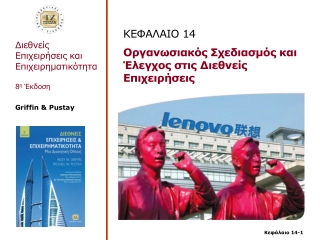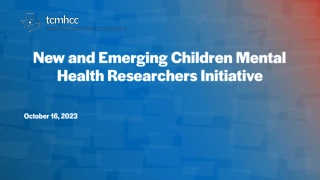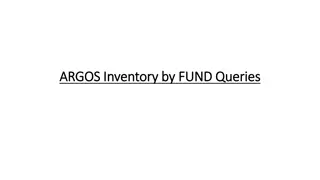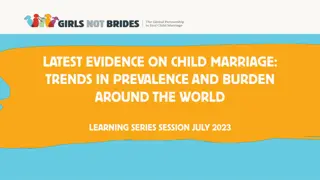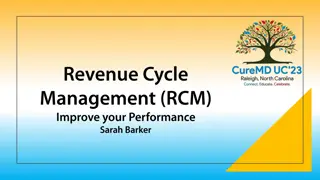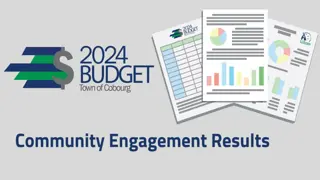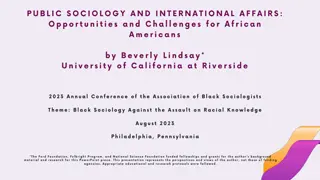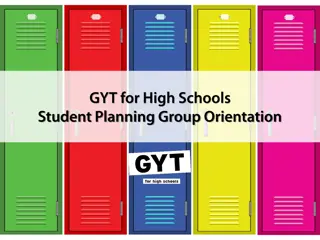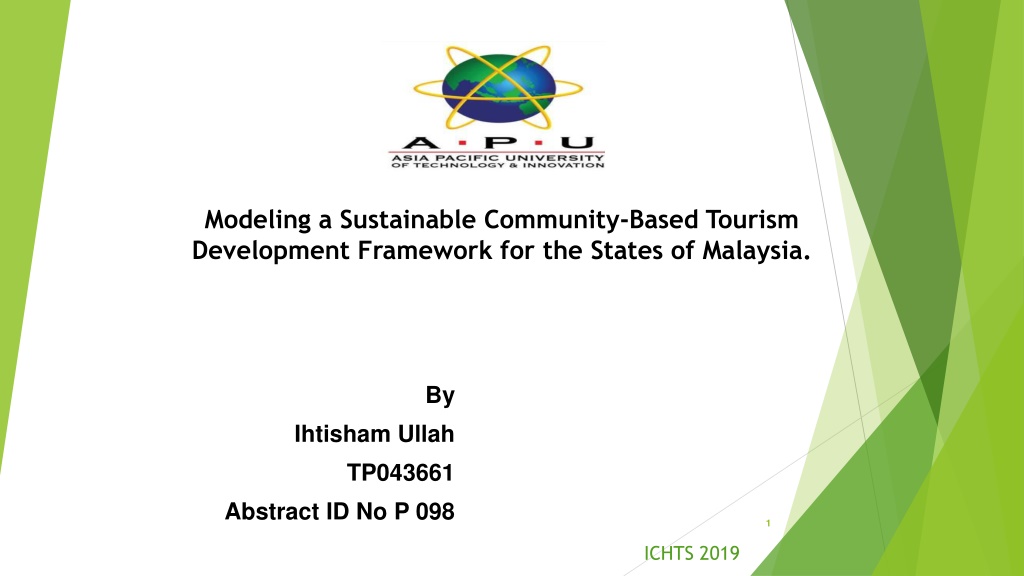
Sustainable Community-Based Tourism Development in Malaysia
This research focuses on developing a framework for sustainable community-based tourism in Malaysia, addressing the challenges faced by operators and measuring the impact on local communities. The study aims to enhance community resources, development, and participation for attaining sustainable tourism practices. Through literature review and a quantitative survey, the research explores concepts like community resources, economic sustainability, and capacity building. Methodology involves surveying homestay/CBT operators in Southern Malaysia to gather insights for analysis using Smart PLS.
Download Presentation

Please find below an Image/Link to download the presentation.
The content on the website is provided AS IS for your information and personal use only. It may not be sold, licensed, or shared on other websites without obtaining consent from the author. If you encounter any issues during the download, it is possible that the publisher has removed the file from their server.
You are allowed to download the files provided on this website for personal or commercial use, subject to the condition that they are used lawfully. All files are the property of their respective owners.
The content on the website is provided AS IS for your information and personal use only. It may not be sold, licensed, or shared on other websites without obtaining consent from the author.
E N D
Presentation Transcript
Modeling a Sustainable Community-Based Tourism Development Framework for the States of Malaysia. By Ihtisham Ullah TP043661 Abstract ID No P 098 1 ICHTS 2019
Problem Statement Many community-based tourisms have lost their ability to sustain (Kumar, 2012). so the success rate of these projects has not been monitored and reported. The actual benefit and impact of these tourism development programmes to the local communities are not easily ascertained (Kumar et al. 2012). Most of the research done in the past was to measure the satisfaction level of tourists with the services provided by the community-based tourism operators (Prabhakaran, 2014) local community participation in the implementation of the community-based tourism programmes. Inadequate research on sustainable community-based tourism practice creates a gap in this research area (Kunasekaran et al., 2017). There are very few studies on community resources (Kunasekaran, 2014). Community participation in sustainable community-based tourism development (Prabhakaran et al., 2014; Kumar et al., 2012). 2 ICHTS 2019
Research Objective Main Objective Specific Objective To highlight the common issue and challenges faced by the Homestay/CBT operators in the Southern States of Malaysia. To measure the level of attainment of community resources, community development among the participating communities in order to attain sustainable community-based tourism development. 3 ICHTS 2019
LiteratureReview Introduction Community Development Sustainable Community-Based Tourism underpinning Theories and Models Community Development Community Resources Homestay/CBT Tourism Social Exchange Theory Natural Participation Cultural Capacity Building Human Human Empowerment Financial Financial summery 14 ICHTS 2019
Conceptual Framework Community Resources Physical resources Human resources Cultural resources Financial Resources Sustainable Community-Based Tourism Development Economic sustainability Socio-Cultural sustainability Environmental Community Development Participation Empowerment Capacity Building 5 ICHTS 2019
METHODOLOGY Research Design: Quantitative research, survey using questionnaire. Population & Sampling Frame: Homestay/CBT operators in Sothern States of Malaysia (922). Sample: 272 respondents, justified by Raosoft, Morgan and krejcie. Instruments : adapted from past researchers using 5 points Likert scale: Data Analysis: using Smart PLS (TWO stage Approach). ICHTS 2019
RESULTS DESCRIPTIVE DATA PROFILE FREQUENCY PERCENTAGE Age : Below 30 30-45 46-60 Above 60 11 90 104 67 4.0 33.1 38.2 24.6 Academic Qualification: 3.7 33.5 51.5 7.7 3.3 None 10 91 140 21 10 Primary School High School Graduates Post Graduates Homestay Tourism Yes (Full time) No (Part Time) 70 202 35.7 29.4 ICHTS 2019
Factor Loading of Measurement Model First Order Constructs Capacity Building Items CB1 CB2 CB3 CB4 CB5 CR2 CR4 CR5 Loadings Constructs Items Loadings 0.785 Human Resources HR1 0.798 0.798 HR2 0.853 0.837 HR3 0.826 0.744 HR4 0.812 0.691 Cultural Resources 0.768 HR5 0.746 0.780 Participation P1 0.668 0.648 P2 0.770 Economic Sustainability ECS1 0.789 P3 0.833 ECS2 0.841 P4 0.780 ECS3 0.889 P5 0.770 ECS4 0.843 P6 0.807 ECS5 0.624 Physical Resources PR1 0.756 Empowerment EMP2 0.763 EMP3 0.836 PR2 0.878 EMP4 0.834 PR3 0.876 EMP5 0.813 PR4 0.824 Environmental Sustainability ES1 0.865 PR5 0.800 Socio-Cultural Sustainability ES2 0.891 SCS1 0.829 ES3 0.838 ES4 0.875 SCS2 0.868 ES5 0.807 SCS3 0.843 Financial Resources FR1 0.478 FR2 0.786 SCS4 0.879 FR3 0.827 SCS5 0.771 FR4 0.822 ICHTS 2019 FR5 0.841
Results of Measurement Model (First order) Composite Reliability : >0.70 Average Variance Extracted (AVE) : >0.50 Latent Variable Items CR AVE 5 Capacity Building 0.881 0.597 5 Cultural Resources 0.777 0.539 5 Economic Sustainability 0.899 0.644 5 0.885 0.659 Empowerment 5 0.932 0.732 Environmental Sustainability 5 0.871 0.582 Financial Resources 5 0.904 0.653 Human Resources 6 0.899 0.598 Participation 5 0.916 0.686 Physical Resources 5 0.922 0.703 Socio-Cultural Sustainability ICHTS 2019
Discriminant Validity - Fornell-Larcker criterion (First Order). CB CR ECS EMP ES FR HR PAR PR SCS CB CR ECS EMP ES FR HR PAR PR SCS 0.773 0.344 0.525 0.061 0.425 0.552 0.254 0.576 0.474 0.427 0.734 0.476 0.138 0.349 0.304 0.674 0.370 0.226 0.395 0.803 0.142 0.606 0.310 0.335 0.368 0.355 0.594 0.812 0.122 0.112 0.104 0.030 -0.063 0.090 0.856 0.206 0.338 0.376 0.383 0.769 0.763 0.289 0.500 0.457 0.174 0.808 0.422 0.228 0.359 0.773 0.569 0.392 0.828 0.329 0.839 ICHTS 2019
Measurement Model Second Order Constructs CS Items Loadings CR AVE CR 0.749 0.732 0.527 FR 0.619 HR 0.738 PR 0.665 CD CB 0.901 0.788 0.483 EMP 0.218 P 0.850 SCTD ES 0.850 0.909 0.770 ECS 0.893 SCS 0.889 ICHTS 2019
Measurement Model for Second Order Constructs: R2 value for this model is 0.358 According to Hair et al., (2017) Structural Model includes determining of R square value R square value for this model is 0.358. This value is moderate as per suggested by Chin et al., (1998). Values of effect size was assessed based on guidelines provided by Cohen (1988). Effect size values of 0.02, 0.15 and 0.35 represent small, medium and large respectively. ICHTS 2019
Results Direct Model Relationships Beta SD T P UL LL f2 VIF Decision Value Value Supported CD -> SCTD 0.336 0.075 4.450 0.000 0.191 0.483 0.097 1.806 Supported CR -> SCTD 0.319 0.070 4.594 0.000 0.186 0.458 0.088 1.806 ICHTS 2019
DISCUSSION & CONCLUSION Direct significant relationship between CR &SCBTD. Direct significant relationship between CD & SCBTD supported by (Kunasekaran et al., 2017) survey that CD are part of the SCBTD. ICHTS 2019

